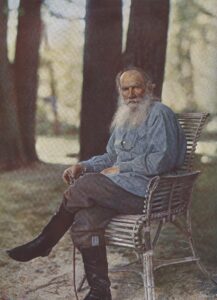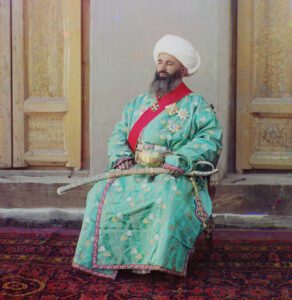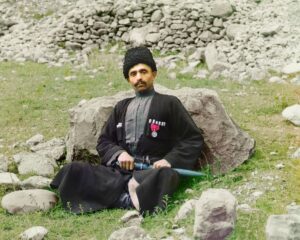
Dagestani Sunni Muslim, 1904 man wearing traditional dress and headgear
by Colin Fell

In the chaos of 1918, a few months after the Bolshevik revolution which would transform Russia, a middle aged man boarded a train bound for Norway, unaware that he would never again see his beloved motherland. Although he had left behind him his money and property, he wasn’t travelling light – with him he had nearly 2000 heavy photographic plates, some of which were impounded by officials who considered that they revealed strategically sensitive material. The man was Sergei Prokudin-Gorskii, one of the pioneers of colour photography, and in his travelling cases he carried an extensive pictorial record of a country about to vanish forever.
Prokudin-Gorskii had come to photography gradually – initially a student of chemistry in St Petersburg, with ambitions on the violin, he had been introduced to orthochromatism (correct colour) by Dr Wilhelm Vogel in 1890s Berlin. Realising the potential for his work, he secured an audience with Tsar Nicholas II and the Imperial Court at the palace of Tsarskoe Selo in the winter of 1909. His audience was suitably impressed by his carefully chosen and apolitical montage of pictures of birch trees, flowers, and devout peasants, the result being unqualified Royal approval, with a written permit to go anywhere in the Russian Empire and see anything – remarkable at a time when so much was closed even to its own citizens. He was given a specially modified Pullman coach with its own darkroom and accommodation for his son Dmitri. There was also a ship, enabling exploration of the Mariinsky canal system and the Volga.
Prokudin-Gorskii’s brief was to record the rich variety of the Empire, its churches, villages, industries, railways and the diversity of its peoples, and for five years, from 1909 until an Archduke was shot in Sarajevo, he travelled, doing just this, poignantly unaware that he was recording a world about to disappear. He had begun, the previous summer, with portraits of Lev Tolstoy, notorious for his furious resistance to being photographed – how Prokudin-Gorskii charmed him is not recorded, or even whether he did. The pictures taken at Yasnaya Polyana capture Tolstoy warts and all; in his peasant blouse and beard he’s both a shout of anger from the 19th–century, and also a prophet of the new order; his basilisk stare of scarcely concealed hostility appears impossible not to interpret as a baleful warning to the bourgeois photographer.
Christopher Isherwood famously introduced his novel Goodbye to Berlin by claiming “I am a camera…recording not thinking…”, and whilst Prokudin-Gorskii might have recognised this humility, many of his pictures have a haunting beauty reflecting his artistry. His portrait of the supervisor of the Chernigov lock gates, one of the few named subjects in the collection, shows an ancient Jewish figure, Pinkhus Karlinsky. In his long overcoat he stands on a small raft, staring out at us with a harrowed, world weary expression. His left hand is concealed beneath the sleeve of his overcoat – has he lost a limb? Yet look at the picture again and it isn’t Pinkhus but Charon, standing on the banks of the Acheron or Styx, awaiting his penny, or kopeck, before he carries us across those darkly silvered waters.
Another picture shows a young man in a skiff, or coracle, piloting it carefully through the reeds in a creek; behind him on the shore stands an observer; it’s Dimitri, Prokudin-Gorskii’s son. The image is simple, yet beautifully composed. The young boat man is captured in a pose which suggests the natural elegance of labour; yet it does not appear to be work as such, rather one of the everyday tasks perennially necessary to human existence; waterways are there, and must be navigated. There is no sense of hurry, or external pressure of time; like an allegorical figure in a Keatsian ode, he appears indifferent to everything except his task, caught in a moment of repose. The site of the picture, the village of Ostrechiny is, like so many of those recorded by Prokudin-Gorskii, changed beyond recognition, the village flooded by the Soviets to create a hydroelectric power station.

Prokudin-Gorskii’s official Imperial brief was to remain apolitical. However, part of the fascination to us, with the dubious advantage of hindsight, and perhaps more attuned to an interpretation of the visual, is the tension between an apparently neutral image and its alternative implicit narratives. Prokudin-Gorskii lovingly recorded the life of the Russian villages and their peasants, recently emancipated from serfdom and considered to be both fiercely devout and unquestioningly loyal to the Tsar. Take his picture of Paltoga, which Prokudin-Gorskii visited during his chronicling of the settlements along the Mariinsky canal, constructed to connect St Petersburg to the Volga. We see an elegant neo-classical church rising above tumbledown log cabins; on the horizon sits a stuccoed manor house. A 21st–century viewer can see how this image can be read in at least two contrasting ways – one can imagine it fulfilling the requirement for a patriotic record of an undeniably picturesque and timeless rural scene, marrying poverty and religious devotion. Yet one can also see how it could also be read as Bolshevik metaphor, the church rising above the downtrodden proletariat in their hovels, whilst the home of the oppressive aristocrat impassively surveys the scene from afar. In the 21st–century we’re ambivalent about rural simplicity, aware of the harsh poverty it often concealed, whilst often yearning for its calming certainties. An image like this one arguably reveals as much about its viewers as it does about its subject. Do you see poverty or peacefulness?
Prokudin-Gorskii’s focus on the work of the countryside is perhaps similarly ambivalent – women spinning wool, cutting flax, washing laundry in the river, are either picturesque or images of drudgery, depending upon one’s perspective on progress – is an activity valuable because it has remained unchanged for thousands of years, or to be thrown aside as an unwanted relic? The end of the 19th–century and the beginning of the 20th were characterised by a sense of the imminence of change, the industrial revolution hastening changes in agricultural practice as well as the migration from country to city- English Literature is full of it, from Hardy’s loving evocations of haymaking in Tess of the D’Urbervilles to E.M.Forster’s exploration of the tensions between ancient and modern in Howard’s End. There’s no suggestion that Prokudin-Gorskii saw these images of country work as anything but evidence of a rural idyll, strengthening his dearly held view that his photography should educate. This sense of didactic purpose found a strong resonance with the Tsar, who told him “I would be very happy if the children who are the same age as my son would learn about our great motherland from your pictures…”, and to us there is perhaps a tragic ingenuousness about the concept of education, which in its Latin root means to draw out, and yet which is so often confused with the less noble practice of instruction or indoctrination. It presumably never occurred to Nicholas II that in using these images for educational purposes, he would be unable to control the lessons drawn by the students. In the end he never had to worry about this – difficulties with mass production of the images and the failure of the Duma to purchase the collection meant that most of the collection remained unseen by Russians.

It’s practically impossible to look at any historical photograph without overlaying a sense of what we know happened afterwards, in the process investing the most commonplace image with pathos, irony and, of course, tragedy. Prokudin-Gorskii spent the year of 1910 exploring the Volga region, and his picture of the city of Rzhev dates from that year. A pontoon bridge stretches lazily across the Volga; above its gently sloping banks a dusty street with a few white stuccoed townhouses – beyond them, green fields amidst which sits the occasional manor house. Trying to locate this scene in the present day is almost impossible – the bridge provides a reference point, but Rzhev is only likely to be known now for its battles of 1941-3; occupied by the Nazis, the city came under prolonged siege from the Soviets. It is difficult to reconcile Prokudin-Gorskii’s image of a sleepy small town on a forgotten summer’s day, with its subsequent destiny. The name now evokes a litany of the horrors of the 20th–century deportation of citizens to Nazi concentration camps, the destruction of most of its buildings, and the inconceivable scale of death in what became known as the Rzhev meat grinder; estimates of Soviet casualties continue to vary between 400000 and a scarcely imaginable 2 million.
Prokudin-Gorskii knew nothing of the future of course, any more than any of us do – his fate was simply to record a present which turned, more quickly than most, to past. Through the 1920s he was to be found in Nice, displaying his pictures to small crowds of fellow emigres, but by the time the Rzhev he had pictured that undated summer’s day was being systematically reduced to rubble-filled killing fields, he was in Paris, where he died in September 1944, a month after the liberation of the city. His sons Dmitri and Mikhail inherited a collection which somehow seemed worthless – who would want it? Certainly not Stalin’s Soviet Union, belligerently intent on obliterat
ing as much of Russia’s past as it could, and scarcely in the mood for misty-eyed nostalgia. Three years after Roosevelt and Stalin’s unlikely meeting at Yalta, it was the USA which recognised the value of the collection. A Princess Marie Putiatin, working on a translation of a nine volume History of Russian Art, summoned a vague memory of these remarkable images, and persuaded the American Council of Learned Societies to purchase the entire collection for $5000. Subsequently digitised, the collection is now democratically available in the way that Prokudin-Gorskii originally intended, although to an audience he could never have imagined, and with an effect he could certainly never have imagined. Conceived as a heritage project for an unbroken line of Romanovs stretching on into the future, it has come to represent both an Ozymandian hubris, and nostalgia in photographic form.
I don’t suppose that Prokudin-Gorskii knew A. E. Housman’s A Shropshire Lad, published in 1896. But it’s easy to imagine the elderly Russian in his Parisian apartment, where surely he felt, like Housman, that “Into my heart an air that kills/From yon far country blows…” He must, too, have been piercingly aware of “those blue remembered hills… spires…farms”; that they were, in fact, “the land of lost content”. And quite certainly, as he faced death in exile, he thought of “The happy highways where I went/ And cannot come again.”
The Prukudin-Gorskii archive is available: here
Volume 35 no 1 September / October 2020

